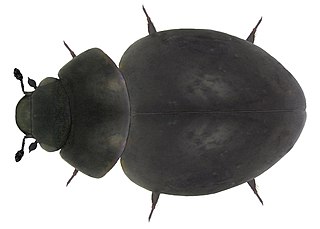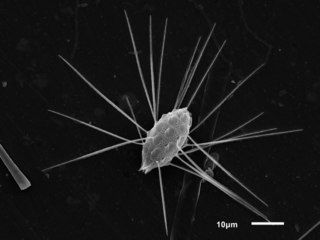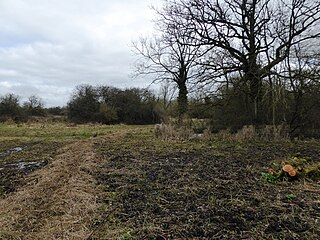
Beetles are insects that form the order Coleoptera, in the superorder Holometabola. Their front pair of wings are hardened into wing-cases, elytra, distinguishing them from most other insects. The Coleoptera, with about 400,000 described species, is the largest of all orders, constituting almost 40% of described insects and 25% of all known animal species; new species are discovered frequently, with estimates suggesting that there are between 0.9 and 2.1 million total species. However, the number of beetle species is challenged by the number of species in dipterans (flies) and hymenopterans (wasps).

Sphaerius is a genus of beetles in the family Sphaeriusidae, comprising 18 species. It is one of the two extant genera in the family, the other being Bezesporum. They are typically found along the edges of streams and rivers, where they feed on algae; they occur on all continents except Antarctica. Three species occur in the United States.

Myxophaga is the second-smallest suborder of the Coleoptera after Archostemata, consisting of roughly 65 species of small to minute beetles in four families. The members of this suborder are aquatic and semiaquatic, and feed on algae.
Eype Mouth is a natural break in a line of sea cliffs on the Jurassic Coast World Heritage Site in west Dorset on the south coast of England. The small River Eype drains into the sea at this point. Eype means 'a steep place' in Old English. The village of Eype lies just upstream of the rivermouth, which is reached by a single narrow lane which runs down through Lower Eype to a shingle beach with car park.

Australoheros is a fish genus in the cichlid family. Most are restricted to rivers and streams in southeastern Brazil, Paraguay, Uruguay and northeastern Argentina, but at least one species is also found in lakes and swamps. This genus was erected after a taxonomic revision in 2006. These are relatively small cichlids that typically do not surpass 10–15 centimetres (4–6 in) in length, although A. facetus reaches about 20 cm (8 in).

Hygrotus is a genus of beetle in family Dytiscidae. It contains two subgenera and about 70 species, including:

The Sironidae are a family of harvestmen with more than 60 described species.
Anomotachys is a genus of ground beetles in the family Carabidae. There are at least three described species in Anomotachys.

Ancyronyx, commonly known as spider water beetles or spider riffle beetles, is a genus of aquatic riffle beetles from North America, South Asia, China, and Southeast Asia. They are small beetles with extremely long legs ending in strong claws. Both the adults and the larvae are found underwater in the shallow riffles of streams and rivers, clinging to rocks or submerged wood. They feed on algae and decaying wood tissue. The genus contains twenty-one species, eleven of which are endemic to the Philippines.
Enielkenie is a genus of East Asian araneomorph spiders in the family Anapidae, containing the single species, Enielkenie acaroides. It was first described by H. Ono, Y. H. Chang & I. M. Tso in 2007, and has only been found in Taiwan.

Mallomonas is a genus comprising unicellular algal eukaryotes and characterized by their intricate cell coverings made of silica scales and bristles. The group was first named and classified by Dr. Maximilian Perty in 1852. These organisms live in freshwater and are widely distributed around the world. Some well known species include Mallomonas caudata and Mallomonas splendens.

Siro is a genus of mite harvestmen in the family Sironidae with 7 described species. All are found in Europe.
Acritus acaroides is a species of clown beetle in the family Histeridae and tribe Acritini. It ranges in size from 0.9-1.1mm, very rarely reaching 2mm. It is found in North America, roughly from eastern Texas to South Carolina.

Weston Fen is a 14-hectare (35-acre) biological Site of Special Scientific Interest north of Weston-on-the-Green in Oxfordshire.
Sphaerius africanus is a species of beetle in the family Sphaeriusidae, discovered in 1997 by Sebastian Endrödy-Younga, being native to South America and having one synonym, Microsporus africanus.









